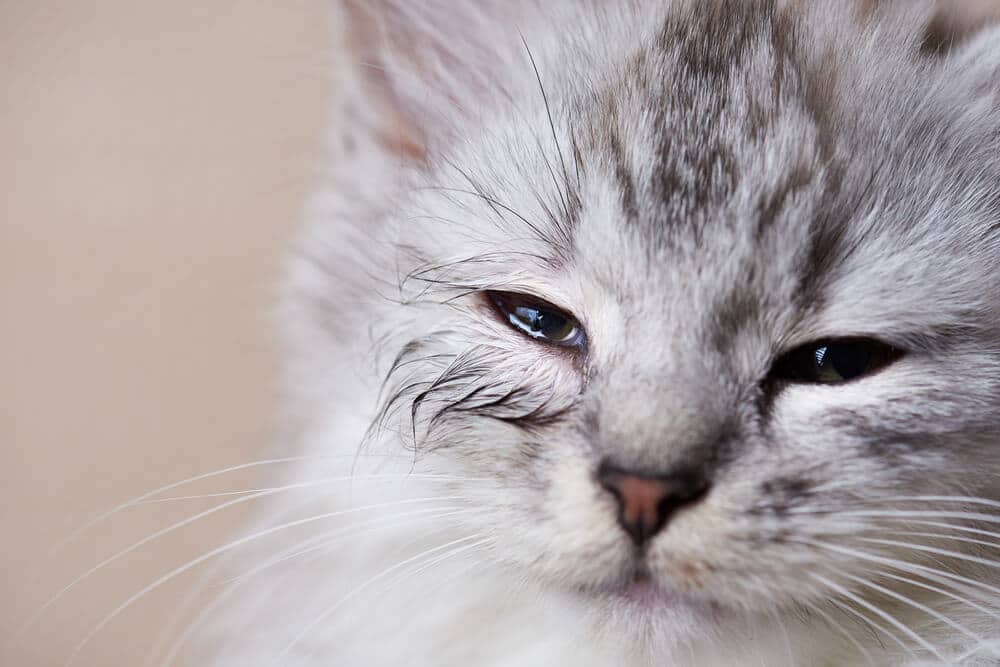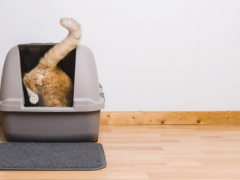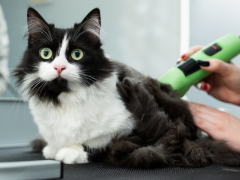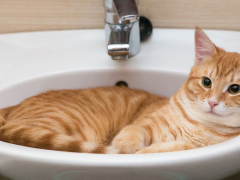
An infection is defined as “the invasion and multiplication of microorganisms such as bacteria and viruses that are not normally present within the body”. A cat eye infection occurs when a cat’s eye is affected by bacterial and viral infections.
Types of Cat Eye Infections
The eye itself is covered in a membrane which is a protective layer of transparent tissue, similar to cling film, and called the “conjunctiva”.
This is the first line of defence for the eye. If infection arrives in the eye area, it is this membrane which becomes infected and inflamed. The correct technical term for this is “conjunctivitis”.
If the front of the eye itself is involved, this is known as “keratitis”. Often both conditions happen together, and the condition is then called “keratoconjunctivitis”.
When people talk about “eye infections”, they normally mean conjunctivitis. Of course, other types of eye infections can occur but they are rare.
An example might be if a cat received a deep scratch to the eye, allowing bacteria to penetrate the eyeball itself, and bypassing the conjunctiva. In that type of situation, the eye would be obviously very severely damaged, and the urgent help of a vet would be essential.
There are two types of conjunctivitis: primary and secondary.
- Primary infections mean that an infectious agent enters the area of the eye and then starts to cause a problem.
- Secondary infections mean that some other issue causes initial damage (e.g. eyelid defects, trauma, irritants, etc) and this then allows bacteria that would normally be kept out to move in, setting up an infection. Primary diseases that affect the immune system such as FIV (Feline AIDS) or feline leukemia may also contribute to eye problems by making the eye more vulnerable to secondary infections.
How Cats Get Eye Infections?
There are four infectious organisms that are common causes of primary conjunctivitis in cats: two bacteria (Chlamydia and Mycoplasma species), and two viruses: Feline Calicivirus (FCV) and Feline Herpes Virus (FHV).
Each of these organisms passes from cat to cat, both by direct contact and by aerosol transmission.
Secondary eye infections start with the initial primary cause, which broaches the eye’s natural defences, and then the secondary bacterial infection starts with contamination with bacteria that are ubiquitous in the environment, but it cannot normally cause infection in a healthy eye without the primary cause setting up the initial damage.
How To Tell if Your Cat Has an Eye Infection?

Cats with an infected eye will often squint and have runny eye discharge.
One or both of your cat’s eyes will look abnormal. The cat may be squinting with the eyes half (or fully) closed. You may be unable to see the eyeball properly due to swelling of the lining of the eye.
There may be discharge from the eyes. The eyes may be runny, with an ocular discharge and wetness. Sometimes yellow or green matter may be seen around the eye, often streaming down the front of the face.
Symptoms of Cat Eye Infection
Conjunctivitis is defined as inflammation of the conjunctiva. The universal signs of inflammation are redness, heat, loss of function, swelling, and pain/ discomfort.
So when the conjunctiva is inflamed, the symptoms reflect these changes:
- Red eyes or pinkness of the eye (sometimes called pink eye)
- Heat around the eye
- Loss of function (the cat may have the eye half-closed)
- Swelling of the conjunctiva (the mucous membrane may be more visible than usual, appearing as a red, fleshy lining of the eye)
- Pain/discomfort which may be seen as itchiness, with the cat rubbing at the eye with their paw, or rubbing their head along the ground
- Watery eyes, sometimes with yellow or green discharge, may be noticed
If the cause of the eye infection is a virus such as Calicivirus or Herpes virus, there may be other signs of an upper respiratory infection such as sneezing and/or nasal discharge. Sometimes the eyeball itself may appear abnormal, with cloudiness or increased pigment on the surface of the eye.
How To Treat a Cat Eye Infection?
First aid for an eye infection involves a pet owner bathing the eye twice daily in mildly salty water. Add a teaspoonful of salt to a pint (450ml) of boiled water. Let the water cool to a comfortable temperature. Moisten a ball of cotton wool with the saltwater solution and apply this gently to the cat’s eye, soaking the discharge to make it easier to wipe off. Repeat this every two hours.
If the eye condition is not back to normal after twenty-four hours of this treatment, you should take your cat to your local DVM veterinarian without delay.
Cat Eye Infection Treatment
Veterinary medicine has learned a great deal about eye infections in cats, and a visit to your vet is essential to deal effectively with all eye issues.
Here’s how your veterinarian may treat your cat’s eye infection:
- Your vet will carry out a full examination of the eye, checking for any underlying causes of the eye infection.
- Cytology (diagnostic cell analysis) may be carried out, with the vet collecting a sample from the eye to examine under the microscope.
- A Schirmer Tear Test may be carried out to measure the cat’s tear production to rule out dry eye (or keratoconjunctivitis sicca), which happens when a cat stops producing the normal amount of tears.
- Swabs may be sent off to the laboratory to carry out extra tests for a causative agent such as Chlamydia.
- Fluorescin dye may be applied to the eye to check for any damage to the cornea (the surface of the eye) such as corneal ulcers or scratches. The dye will also allow the vet to confirm that your cat’s tear ducts are functioning normally.
- Finally, the vet may apply local anaesthetic drops to the eye to allow the third eyelid to be lifted up so that the vet can check for any foreign bodies that may be trapped beneath this, causing discomfort and damage.
- Once this detailed examination has been carried out, the vet should be able to make a provisional diagnosis, and then give appropriate treatment.
Cat Eye Infection Medications
Eye medications may initially involve antibacterial drops or eye ointment, applied three or four times daily for most drops, although there is one type of antibiotic ointment (fusicidic acid) which only needs to be applied once daily. Treatment is usually given for five days but may be for longer in some cases.
If a confirmed diagnosis is made of Chlamydia or Mycoplasma, systemic treatment with a specific oral antibiotic such as doxycycline (as tablets) may be recommended. If a diagnosis of Feline Herpes Virus is made, topical antiviral medication may be suggested, as well as the possibility of systemic antiviral medication.
Over The Counter Treatment
Over the counter topical drops may be available: phropamidine isethionate (“Brolene”) is an antiseptic which has some effect against some bacteria. This is not licensed for cats, however, and it should definitely not be used for severe cases.
How to Treat My Cats Eye Infection at Home?
The best home remedy is to simply use saline (mildly salty water) as outlined above. Use a cotton ball moistened with this to clean any eye discharge away, four times daily. Be careful to wipe away from the eye each time, being sure that you do not reinfect the eye by moving debris inwards rather than outwards.
Eye health is important, and sore eyes should always be taken seriously by cat carers, since the eyes are delicate structures that can easily be permanently damaged. The advice of a veterinarian should always be sought to ensure that the most appropriate treatment can be given.
Frequently Asked Questions
Will a cat eye infection heal on its own?
Some primary causes of eye infections of cats (such as herpes virus) may come and go naturally, similar to herpes cold sores in humans. However, it’s best to take all cats with sore eyes to the vet, so that a proper professional evaluation can be carried out.
Are cat eye infections contagious to humans?
In most cases, cat eye infections cannot be passed on to humans, but one infectious agent that affects cats, Chlamydia, has rarely been identified as a cause of conjunctivitis in humans. For this reason, hygienic measures should be taken, including washing your hands carefully after handling your cat, and in particular, after treating your cat’s eyes.
How much does treatment cost?
The main cost of treating a cat eye infection is the professional examination and diagnostic tests that are needed to make an accurate diagnosis of the cause. Treatment generally involves eye drops and ointments which may cost less than $20, plus sometimes oral medication which may cost less than $40 for a course.








Thank you for the eye infection in cats info. I’m trying to seek help for a feral cat with eye infection/sneezing issues.
This is difficult, as for the optimal treatment cats need to be physically examined, and treatment needs to be given for a sustained period including topically into the eyes. This can involve trapping sick cats and taking them to local veterinarians. The best answer is probably that you try to contact local feral cat advocates and see if they can help you do this. The best of luck. Pete
You load too many god damned ads on your site. Also the quality of the information is low.
Thank you for making us aware of your bad experience. Ads allow us to pay our writers and support independent reviews, but I understand that the experience is not ideal. We’re looking into what we can do to improve that.